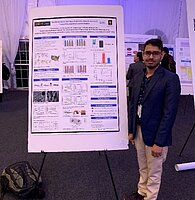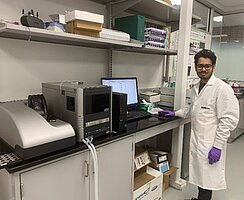Fabrication of Point of Use Treatment Systems for Aqueous Arsenic and their Evaluation

Tonoy Das is a Ph.D. candidate in the Environmental and Conservation Sciences program at North Dakota State University (NDSU). He received bachelor’s in Agriculture (B.Sc.) from Bidhan Chandra Krishi Viswavidyalaya (India) in 2012 and master’s in Soil Science (M.S.) in 2014 Punjab Agricultural University (India). Tonoy started his doctoral work in 2016 with a prestigious NS-ICAR international fellowship from the Government of India to address the global arsenic contamination problem. During his graduate study, Tonoy is working on nanomaterial design and development for potential water treatment applications and environmental remediation. The excellent research effort put up by Tonoy leads numerous journal publications, conference presentations, and establishes collaboration within and outside NDSU.
Fabrication of Point of Use Treatment Systems for Aqueous Arsenic and their Evaluation
Arsenic (As) is a naturally occurring (geogenic) carcinogenic metalloid present in groundwater. Excess arsenic (>10 μg/L) in drinking water is a major public health concern across the globe by affecting more than 200 million people and the number is increasing rapidly. The goal of this research has been to develop a new class of iron-based nanomaterials for arsenic removal which will be an ideal adsorbent and fabricate a sustainable point-of-use water treatment unit for household and small community arsenic removal.
Research progress
We reported a novel graphene oxide iron nanohybrid (GFeN) that achieved removal capacities of 306 mg/g for As(III) and 431 mg/g for As(V) and fast reaction kinetics (remove >99% in less than 10 min). Graphene oxide sheets plays important role in the removal process, we proposed an arsenic removal mechanism where graphene oxide sheets used in the nanohybrid work as electron storage units and the stored electrons help in reactivating the iron as well as reducing the arsenic species to the final zero-valent state. There were negligible interferences by co-existing ions, pH, temperature and organic matters on arsenic removal efficiency at environmentally relevant level. High adsorbing GFeN possess a risk of release of adsorbed arsenic, we evaluated the reliability and stability of arsenic loaded GFeN. In the presence of competing anions and variable pH at environmentally relevant concentration, these nanohybrids showed the release of only < 0.5 % adsorbed arsenic in 24 hr. The adsorbed arsenic on the monohybrid surface remained stable, only ~6% of the adsorbed arsenic was released over ~2 years period. Ultra-high arsenic adsorption capacities, quick removal, and stabilization of adsorbed arsenic for a long period made our nanohybrid a reliable and robust candidate as a filter medium. To ease the application of powder nanomaterial in point of use treatment system we have synthesized polyethersulfone (PES) and cellulose nanofiber (CNF) based composite droplet size spherical beads which successfully entrap the GFeN and recorded efficient arsenic removal. This research is developing a feasible and sustainable arsenic treatment system that will be able to supply millions of people with safe drinking water.
Peer-reviewed Journal Papers
Das, T.K.,and Bezbaruah, A.N. 2021 Comparative Study of Arsenic Removal by Iron-based Nanomaterials: Potential Candidates for Field Applications. Science of the Total Environment. 142914.
Das, T.K., Sakthivel T.S., Jeyaranjan A., Seal S., Bezbaruah, A.N. 2020 Ultra-high arsenic adsorption by graphene oxide iron nanohybrid: Removal mechanisms and potential applications. Chemosphere. 126702.
Conference presentations and seminars
Das, T.K., Sakthivel T.S., Seal S, Bezbaruah A.N. 2019. Mechanism(s) of arsenic desorption from graphene oxide-metal oxide nanohybrids. 8th Sustainable Nanotechnology Conference (San Diego, CA, USA) from November 7-10, (Oral Presentation).
Das, T.K., Bezbaruah, A.N. 2019. Practical relevance of Graphene oxide supported iron nanohybrid in arsenic remediation. Association of Environmental Engineering and Science Professors (AEESP) Distinguished Lecture. (University of Minnesota, MN, USA) November 1 (Poster Presentation)
Das, T.K., Bezbaruah, A.N. 2019. Arsenic Removal by Graphene-oxide Iron Nanohybrid: Spectroscopic and Microscopic Studies. NDEPSCoR Conference, Fargo, ND, USA (Poster).


Achintya Bezbaruah
Civil & Environmental Eng.
Office: Civil/Ind Eng 201G
Telephone: 701-231-7461
Email: a.bezbaruah@ndsu.edu


